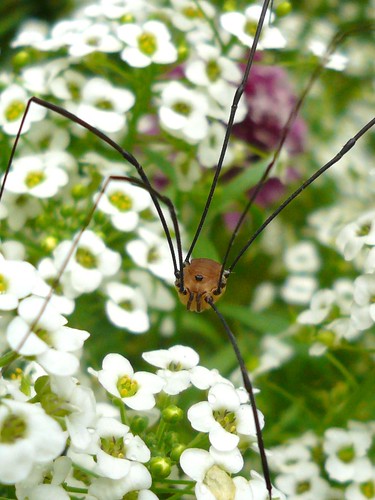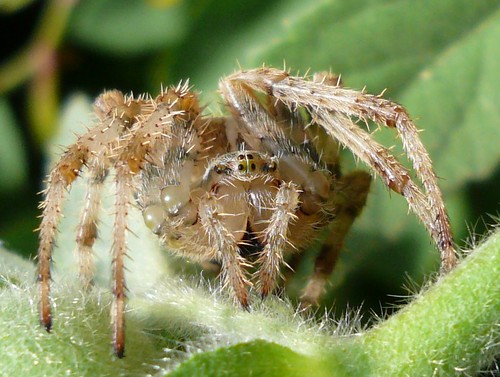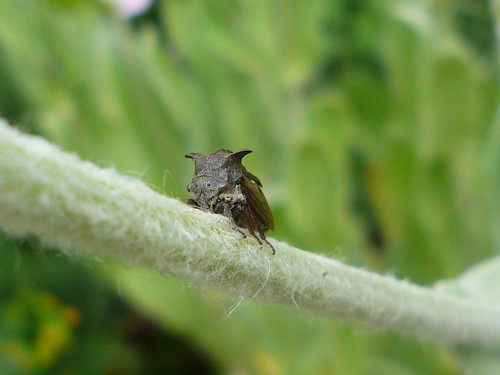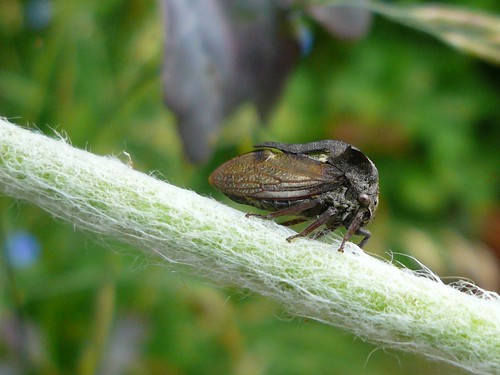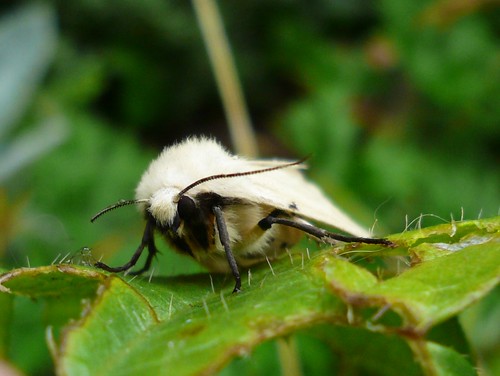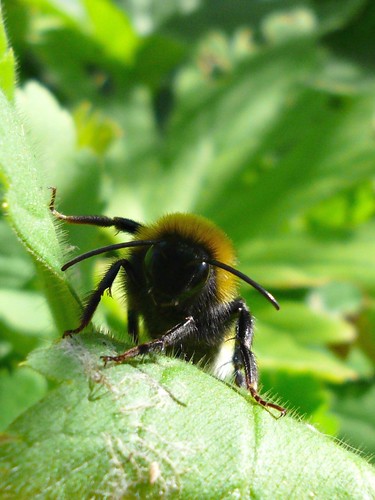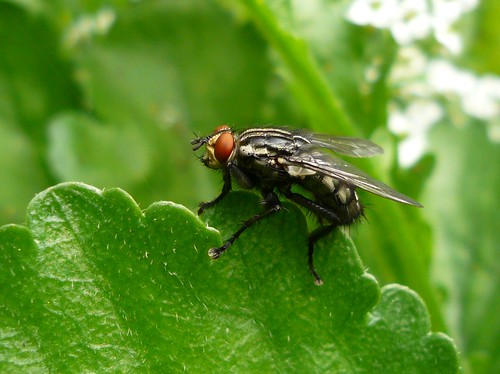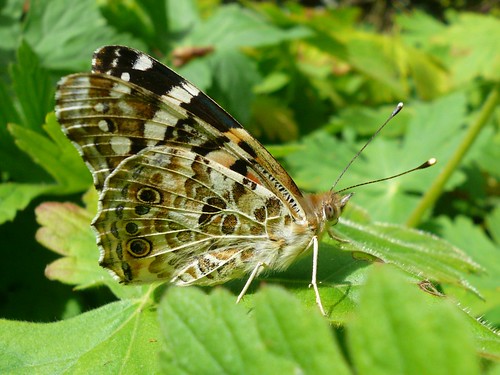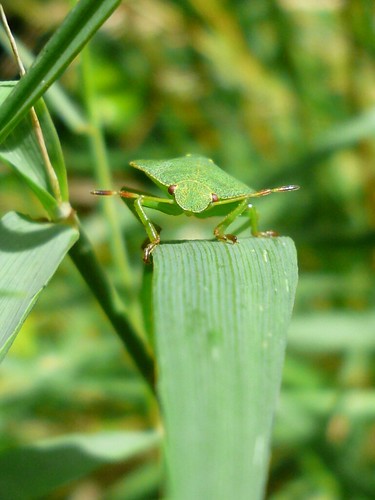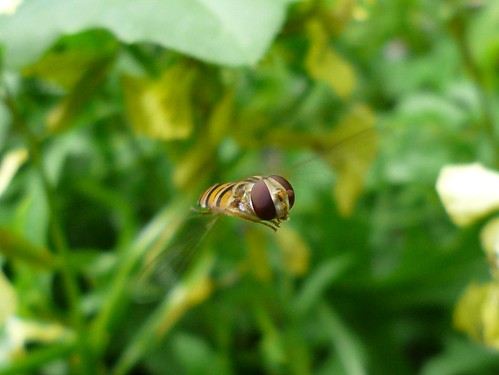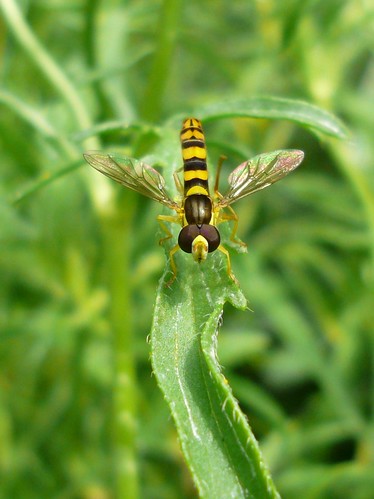There are several species of harvestman in the UK. They are often mistaken for a spider (they are related), but there is no 'waist' and they do not produce either silk or venom. Their eight very long legs look ungainly but they can move surprisingly fast through foliage. Those legs are vulnerable, however, and I often see individuals with one or more legs missing, as with this one. I always think they look rather alien when you see them face on, with their eyes close together up on that ridge in the centre of the head.
Saturday, 22 August 2009
Harvestman (Leiobunum rotundum)
Thursday, 13 August 2009
Garden Orb Spider (Araneus diadematus)
The stuff of nightmares for some, I find this photograph beautiful. You can see close up the amazing architectural structure of the spider, and I especially like the ball joints in the legs. This extremely common spider can reach a body size of 16mm or more. The colouring varies from dark brown to oranges, but there is always a pale cross-shaped mark on the abdomen. It spins the traditional circular web and is usually seen sat in the centre awaiting prey. The eight eyes are arranged as a central group of four, with two pairs further round each side of the head.
Field Grasshopper (Chorthippus brunneus) Nymph
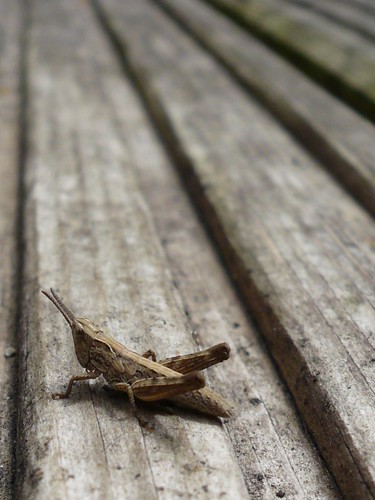
Field Grasshopper (Chorthippus brunneus) Nymph, originally uploaded by Pipsissiwa.
Identification via mountainashe (Ashley Wood) from Wild Things / Chinery / McGavin.
My beloved grasshoppers. I love them. The adult of this species is large (15-25mm) and highly variable in colour from browns, rusty reds or oranges, greys and greens. I get all variations in the garden, but especially the red and browns. It is recognisable by the sharply angled keels on the top of the thorax and the furred underside. This nymph is just starting to develop wings; tiny little flaps on the thorax at the moment.
Wednesday, 12 August 2009
Beetle (Strangalia maculata)

Wasp Beetle (Strangalia maculata), originally uploaded by Pipsissiwa.
I spotted this guy the year after I created my first log pile, and to my delight this large insect was climbing out of it. Given their larvae live on rotten wood, I'm hoping that means they are breeding in the garden. I've never seen one of these before, and it took me by surprise when it flew across the garden to bask on an ivy leaf. What a wonderful, striking example for my first sighting of any long-horn beetle ever.
Invertebrate Species Found So Far...
This is the list so far of invertebrate species that I have identified in my garden.
INSECTS:
Orthoptera
- Field Grasshopper (Chorthippus brunneus)
- Speckled Bush Cricket (Leptophyes punctatissima)
Coleoptera
- Thick-Legged Flower Beetle (Oedemera nobilis)
- Wasp Beetle (Strangalia maculata)
- 7-Spot Ladybird (Coccinella 7-punctata)
- Rove Beetle (Several species)
- Flea Beetle (Aphthona flava) and others.
- Rosemary Leaf Beetle (Chrysolina americana)
- Beetle (Pterostichus cupreus)
- Pollen Beetle (Meligethes aeneus)
- Vine Weevil (Otiorhynchus sulcatus)
- Weevil (Anthonomus pomorum)
- Harlequin Ladybird (Harmonia axyridis)
- Beetle (Lagria hirta)
Diptera
- Greenbottle Fly (Lucilia caesar)
- Common Housefly (Musca domestica)
- Fleshfly (Sarcophaga carnaria)
- Drone Fly (Eristalis tenax)
- Spotted Cranefly (Nephrotoma appendiculata)
- Cranefly (Tipula oleracea)
- Mosquito (Culiseta annulata)
- Fly (Sepsis fulgens)
- Robber Fly (Several species)
- Hoverfly (Melanostoma scalare)
- Brindled Hoverfly (Helophilus pendulus)
- Hoverfly ( Sphaerophoria scripta)
- Hoverfly (Episyrphus balteatus)
- Pale-Footed Hoverfly (Platycheirus albimanus)
- Thick-Legged Hoverfly (Syritta pipiens)
- Hoverfly (Scaeva pyrastri)
- Hoverfly (Myathropa florae)
- Lesser Banded Hoverfly (Syrphus vitripennis)
- Tapered Drone Fly (Eristalis pertinax)
- Large Narcissus Fly (Merodon equestris)
- Fly (Rhingia campestris)
- Chironomid (Chironomus luridus)
Heteroptera
- Blackfly (Aphis fabae)
- Green Shield Bug (Palomena prasina)
- Common Green Capsid Bug (Lygocoris pabulinus)
- Damsel Bug (Himacerus mirmicoides)
- Grass Bug (Stenodema laevigata)
- Bug (Dicyphus epilobii)
- Bug (Capsus ater)
- Dock Bug (Corius marginatus)
- Ant Damsel Bug (Himacerus apterus)
- Ant Mimic Bug (Myrmecoris gracilis)
- Flower Bug (Capsodes gothicus)
- Common Flower Bug (Anthocoris nemorum)
- Leaf Bug (Notostira elongata)
- Common Froghopper (Philaenus spumarius)
- Jumping Plant Louse (Psyllopsis sp.)
- Horned Treehopper (Centrotus cornutus)
- Leafhopper (Hauptidia maroccana)
- Sage Leafhopper (Eupteryx melissae)
Lepitoptera
- Scarlet Tiger Moth (Callimorpha dominula)
- Plume Moth (Emmelina monodactyla)
- Plume Moth (Amblyptilia acanthadactyla)
- White Plume Moth (Pterophorus pentadactyla)
- Buff Ermine Moth (Spilosoma luteum)
- Large White Butterfly (Pieris brassicae)
- Nettle-tap Moth (Anthophila fabriciana)
- Red Admiral Butterfly (Vanessa atalanta)
- Small White Butterfly (Pieris rapae)
- Silver Y Moth (Autographa gamma)
- Comma Butterfly (Polygonia c-album)
- Red Admiral Butterfly (Vanessa atalanta)
- Painted Lady Butterfly (Vanessa cardui)
- Peacock Butterfly (Inachis io)
- Garden Carpet Moth (Xanthoroe fluctuata)
- Speckled Wood Butterfly (Pararge aegeria)
- Meadow Brown Butterfly (Maniola jurtina)
- Moth (Syndemis musculana)
- Moth (Pyrausta purpuralis)
- Double Striped Pug Moth (Gymnoscelis rufifasciata)
Hymenoptera
- Rose Sawfly (Arge ochropus)
- Rose Sawfly (Arge pagana)
- Ichneumon (Ichneumon suspiciosus)
- Wool Carder Bee (Anthidium manicatum)
- White-Tailed Bumblebee (Bombus lucorum)
- Bumblebee (Bombus lapidarius)
- Bumblebee (Bombus terrestris)
- Bumblebee (Bombus pascuorum)
- Honey Bee (Apis mellifera)
- Mining Bee (Andrena sp.)
- Mason Wasp (Ancistrocerus nigricornis)
- Black Garden Ant (Lasius niger)
- Red Ants (Myrmica rubra)
Odonata
- Variable Damselfly (Coenagrion pulchellum)
- Neuroptera
- Lacewing (Micromus variegatus)
- Lacewing (Chrysoperla carnea)
SPRINGTAILS:
- Collembola
ARACHNIDS:
- Garden Orb Spider (Araneus diadematus)
- Wolf Spider (Pardosa lugubris)
- Spider (Enoplognatha ovata)
- Zebra Spider (Salticus scenicus)
- Female Crab Spider (Misumena vatia)
- Foliage Spider (Clubiona terrestris)
- Jumping Spider (Heliophanus cupreus)
- Jumping Spider (Heliophanus flavipes)
- Green Orb Spider (Araniella curcurbitina)
- Harvestman (Leiobunum rotundum)
- Harvestman (Odiellus spinosus)
- Harvestman (Opilio parietinus)
- False Widow Spider (Steatoda grossa)
- Daddy-Long-Legs Spider (Pholcus phalangioides)
- Red Spider Mite (Tetranychus urticae)
- Large Jawed Orb Spider (Tetragnatha montana)
- Crab Spider (Xysticus cristatus)
- Spider (Araniella cucurbitina)
- Spider (Steodata nobilis)
- Crab Spider (Philodromus dispar)
CRUSTACEANS
- Common Woodlouse (Oniscus asellus)
- Common Rough Woodlouse (Porcellio scaber)
- Pill Woodlouse (Armadillidium vulgare)
MOLLUSCS
- Garden Snail (Helix aspersa)
- Snail (Oxychilus cellarius)
- Yellow Slug (Limax flavus)
- Garden Slug (Arion hortensis)
- Amber Snail (Succinea putris)
- Netted Slug (Deroceras reticulatum)
ANNELIDS:
Horned Treehopper (Centrotus cornutus)
I was hugely excited to find this chap. One of only 2 species in the UK, this large (10mm) treehopper is very distinctive. The pronotum is long and curves back over the abdomen, and bears 'horns' on either side. There really is nothing else like it.
Monday, 10 August 2009
Buff Ermine Moth (Spilosoma luteum)
Dense white/cream fur on the thorax with black legs and head make this a distinctive and beautiful moth. The wings are white or cream with a clear line of small spots running diagonally across the forewing, as well as others scattered more randomly. This one was resting for the day on a leaf in a secluded part of the garden, and was woozy enough to be cooperative in the sitting still stakes.
Buff-Tailed Bumblebee (Bombus terrestris)
I found this worker bumblebee still drowsy early one morning, so it was willing to sit still and 'pose' for me. The light wasn't ideal, but I was still delighted with this shot. A large species of bumblebee (Worker: 10-16mm, Queen: 18-20mm) that has deep yellow/orange fur on the 'collar' and 2nd abdominal segment. The tail is usually white in workers and more ginger/buff in the queens.
Flesh-Fly (Sarcophaga carnaria)
A very common but attractive fly, with bright red eyes and large feet. The abdomen is a muted chequered grey and black. They breed, as the name suggests, on the remains of dead animals and are therefore strongly associated with spreading disease. Unusually they do not lay eggs and are in fact viviparous - the female produces live larvae.
Painted Lady Butterfly (Vanessa cardui)
A large butterfly (wingspan 55-60mm) with striking orange, black and white markings. The underside has equally striking, if less colourful, patterning. It is not resident in the UK due to the cold winter but new individuals arrive from southern Europe in the spring.
Sunday, 9 August 2009
Green Shield Bug (Palomena prasina) Nymph
A very common large (12-14mm as adult ) shield bug (Family: Pentatomiae). The nymphs begin almost totally black and each instar becomes progressively more green and shield shaped. Darkens to brown in late autumn before it hibernates.
Hoverfly (Episyrphus balteatus)
A very common large (10-15mm) hover-fly with distinctive additional thin black stripes on the 3rd and 4th abdominal segments. The hovering really helps when trying to capture one in flight, although they do tend to dive around a lot. A bit of patience and I managed to get this shot, which I am delighted with.
Long-Bodied Hover-fly (Sphaerophoria scripta)
A long, slim (10-12mm) hover-fly. The abdominal stripes are variable but it always has a horizontal stripe on each side of the thorax. In the male ( as this one is) the abdomen is noticeably longer than the wings, which makes them a distinctive and attractive hover-fly.
Tree Damsel Bug (Himacerus apterus)
A large bug (8-12mm) with good mottled brown camouflage colouration. The wings are usually shorter than the abdomen. It feeds on small insects and mites, typically on deciduous trees. This one made a good attempt at feeding on me. It sat on my hand for a few minutes and then stabbed its mouth parts into my fingertip. I can vouch for how strong and sharp they are! I just had a small red mark for an hour or so and it was a teeny bit tender, but my the evening it was all gone.
Sick of the 'Dumbing Down' of science
'Minibeast'. I hate that word. Its a generic, catch-all that seems to include everything from micro-organisms to mice, depending on who uses it. I was supposed to use it when teaching. I think not. Why can't we at the least teach 'invertebrate' and 'vertebrate', and preferably some basics about the difference between an insect, a spider, a woodlouse, a snail. Clumping them all together is just stupid. We don't talk about 'maxibeasts' and clump fish, birds, mammals etc together. In fact some 'vegetarians' make a clear distinction between fish and other vertebrates.
When I hear documentary programs and textbooks using this word I shudder.
Some specific recent annoyances:
- The One Show, BBC1. 'Bug Week'. Yet they featured cockroaches, moths, ants.... Why do we have to take the American slang 'bug' to mean all arthropod invertebrates? Its as accurate as, for example, having a 'Butterfly Week' and featuring grasshoppers and beetles. 'Bug' is a taxonomic term meaning an insect with sucking mouthparts, from Order Hemiptera. Wouldn't hurt to use the word 'arthropod', or even 'invertebrate'. No harder to remember.
- Bang Goes the Theory, BBC1. Frying up some scorpions as a demonstration of how nutritious they are, fine. Calling them insects when you are a biologist is unforgivable.
I don't mean everyone has to learn the latin names for animals and understand all the details. But a bit of accuracy would be nice.
Saturday, 8 August 2009
My New Blog
I'm only going to post my very best or most interesting photographs here. If you want to see more, please visit my Flickr photostream (Link to the right :)
